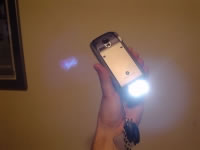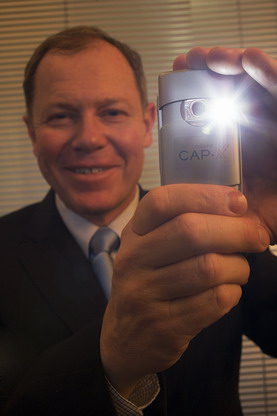BriteFlash for LED Flash Cameraphones
8 March 2006 by axxxr The one thing holding back cameraphones as compared to standalone digital cameras is Flash photography.Even when there's a flash built into the cameraphone, it's usually only good for short distances.
CAP-XX Inc. today announced its BriteFlash power architecture to provide LED flash camera phones with enough light to produce high-resolution images. Some phone manufacturers have experimented with long flash exposure times to compensate for low-light problems, which then result in blurry photographs. CAP-XX's BriteFlash architecture provides enough flash power to eliminate both dark and blurry photos using high-capacitance (0.4 to 1 farad), low equivalent-series-resistance (less than 100 milliohms), thin (1 to 3 millimeters) prismatic supercapacitors to support a battery and deliver the pulse power to drive an LED to full light intensity. CAP-XX also developed the power architecture that optimizes a supercapacitor to power flash LEDs. "Greater than 2-megapixel camera phones require a high-intensity flash in medium to low light conditions to ensure good pictures," said Anthony Kongats, CEO of CAP-XX. "Some solutions are available but lack adequate power to produce quality photos in all light conditions. Our BriteFlash power architecture completes the equation with the power to drive today's LEDs." Today's high-power white LEDs require a higher voltage than a Li-ion battery can supply, so power integrated circuit (IC) suppliers have developed special-purpose DC/DC and charge pump ICs to drive these LEDs. However, these new LEDs need up to 400% more power than a battery can provide to achieve full light intensity. CAP-XX supercapacitors can deliver this pulse power. CAP-XX has developed reference designs using standard flash drivers that offer multiple design options. The CAP-XX BriteFlash power architecture is similar to a Xenon flash solution used in digital cameras today, where a low-current charge pump (boost converter) charges the supercapacitor to 5.5 volts then the supercapacitor drives the LED at very high current for the flash pulse. CAP-XX's supercapacitor-based solution, however, delivers more light energy (flash power x flash duration) and has a much thinner form factor than the Xenon one. Designers are forced to choose thinner, hence reduced-capacitance 330-volt cylindrical electrolytic storage capacitors necessary in Xenon designs to fit them in space-constrained camera phones. These reduced-capacitance electrolytic capacitors, which are still bulky at 6 to 10 millimeters, reduce the light energy the flash can provide. www.cap-xx.com
|








 RSS feed
RSS feed